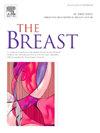Cancer outcomes in patients eligible for adjuvant cyclin-dependent kinase 4 and 6 inhibitors but spared adjuvant chemotherapy by Oncotype Dx: A multicenter retrospective GBECAM 0520 study
IF 7.9
2区 医学
Q1 OBSTETRICS & GYNECOLOGY
引用次数: 0
Abstract
Background
In pivotal CDK4/6 inhibitor (CDK4/6i) adjuvant trials, most patients received chemotherapy (CT). However, the role of CDK4/6i in patients spared CT by a genomic signature remains unclear. We investigated the proportion of patients without genomic CT indication but eligible for adjuvant abemaciclib or ribociclib, and estimated their potential benefit from CDK4/6i.
Methods
This retrospective, real-world study included patients with T1–T3, N0–N1, HR+/HER2− early breast cancer (eBC) who underwent Oncotype DX (ODX) testing (2005–2024) at nine Brazilian institutions. Genomic CT indication followed TAILORx and RxPONDER; CDK4/6i eligibility followed MonarchE and NATALEE. Primary endpoints were 5-year invasive disease-free survival (iDFS) and distant disease-free survival (DDFS) among patients eligible for CDK4/6i, without genomic CT indication, treated with endocrine therapy (ET) alone.
Results
Among 922 patients, ODX showed low (<11), intermediate (11–25), and high (>25) genomic risk in 170 (18.4 %), 585 (63.5 %), and 167 (18.1 %), respectively. Overall, 24 (2.6 %) and 120 (13 %) were eligible for abemaciclib and ribociclib, respectively, had no CT indication, and received ET alone. In these patients (median follow-up: 57.8 and 66.4 months), 5-year iDFS and DDFS were 100 %.
Conclusions and relevance
HR+/HER2− eBC patients eligible for CDK4/6i but spared CT by ODX are a minority and have excellent outcomes with ET alone. This highlights the potential benefits of integrating genomic and clinical risk stratification to refine therapeutic decision-making regarding the need for CDK4/6i.
适合接受辅助周期蛋白依赖性激酶4和6抑制剂但不接受Oncotype Dx辅助化疗的患者的癌症结局:一项多中心回顾性GBECAM 0520研究
在关键CDK4/6抑制剂(CDK4/6i)辅助试验中,大多数患者接受化疗(CT)。然而,CDK4/6i在基因组标记的免CT患者中的作用仍不清楚。我们调查了没有基因组CT适应症但符合辅助abemaciclib或ribociclib的患者比例,并估计了他们从CDK4/6i中获得的潜在益处。方法:这项回顾性的真实世界研究纳入了2005-2024年在巴西9家机构接受Oncotype DX (ODX)检测的T1-T3、N0-N1、HR+/HER2−早期乳腺癌(eBC)患者。采用TAILORx和RxPONDER进行基因组CT适应症检查;CDK4/6i资格紧随MonarchE和NATALEE之后。主要终点是符合CDK4/6i治疗条件、无基因组CT指征、单独接受内分泌治疗(ET)的患者的5年侵袭性无病生存期(iDFS)和远端无病生存期(DDFS)。结果922例ODX患者中,低(<11)、中(11 - 25)、高(>25)基因组风险分别为170例(18.4%)、585例(63.5%)、167例(18.1%)。总的来说,24例(2.6%)和120例(13%)分别符合abemaciclib和ribociclib的条件,没有CT指征,单独接受ET治疗。在这些患者中(中位随访:57.8个月和66.4个月),5年iDFS和DDFS均为100%。hr +/HER2 - eBC患者符合CDK4/6i,但ODX免除CT是少数,单独使用ET有很好的结果。这突出了整合基因组和临床风险分层来完善关于CDK4/6i需求的治疗决策的潜在益处。
本文章由计算机程序翻译,如有差异,请以英文原文为准。
求助全文
约1分钟内获得全文
求助全文
来源期刊

Breast
医学-妇产科学
CiteScore
8.70
自引率
2.60%
发文量
165
审稿时长
59 days
期刊介绍:
The Breast is an international, multidisciplinary journal for researchers and clinicians, which focuses on translational and clinical research for the advancement of breast cancer prevention, diagnosis and treatment of all stages.
 求助内容:
求助内容: 应助结果提醒方式:
应助结果提醒方式:


